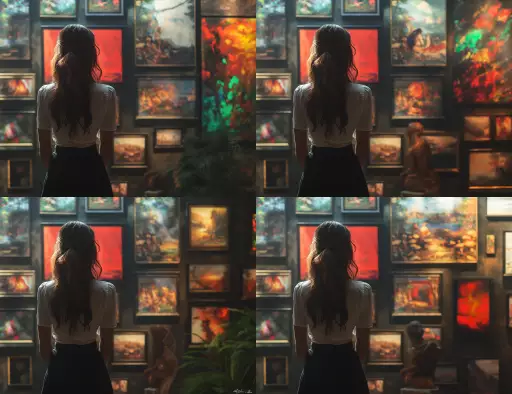Explore the Best AI Image Gallery

Beyond Reality: VR & AR in Gaming and the Creative Revolution
The gaming industry has long been at the forefront of technological innovation, pushing boundaries and redefining entertainment. Today, virtual reality (VR) and augmented reality (AR) stand poised to usher in a new era, not just for gaming but also for the creative industries as a whole. These immersive technologies are blurring the lines between the digital and physical worlds, opening up exciting possibilities for artists, designers, and storytellers.
A New Playground for Creativity
VR & AR offer creators an unprecedented canvas to bring their visions to life. Imagine crafting interactive worlds where users can become part of the narrative, exploring intricate environments, and manipulating objects in real-time.
Game Design Reimagined
- Immersive Storytelling: VR transports players directly into the heart of a story, fostering a deeper emotional connection with characters and worlds.
- Interactive Environments: Players can explore expansive, richly detailed landscapes, interacting with objects and characters in ways previously unimaginable.
- New Gameplay Mechanics: VR & AR introduce novel controls and interactions, enabling innovative gameplay mechanics that leverage the physical capabilities of the player.
Beyond Entertainment: Applications Across Industries
The impact of VR & AR extends far beyond gaming. These technologies are finding applications in diverse fields:
- Education and Training: Immersive simulations provide realistic training environments for professions such as surgery, flight simulation, and emergency response.
- Architecture and Design: Architects can walk through virtual models of buildings, allowing clients to visualize spaces before construction begins. Designers can experiment with different materials and textures in a digital environment.
- Healthcare: VR is used for pain management, therapy, and rehabilitation, while AR assists surgeons during complex procedures by overlaying patient data onto the operating field.
Ethical Considerations: Navigating Uncharted Territory
As with any powerful technology, VR & AR raise ethical considerations that require careful attention:
- Data Privacy: VR & AR systems often collect vast amounts of user data. Ensuring the privacy and security of this information is paramount.
- Accessibility and Inclusivity: Making VR & AR technologies accessible to individuals with disabilities is crucial for equitable access to these immersive experiences.
- Content Responsibility: The creation and distribution of VR & AR content must be guided by ethical principles to avoid harm, manipulation, or the spread of misinformation.
The Future Landscape: A Convergence of Worlds
Looking ahead, the convergence of VR, AR, and other emerging technologies will shape the future of creativity. We can expect:
- More Realistic and Immersive Experiences:** Advancements in graphics processing, haptic feedback, and AI will create increasingly realistic and engaging virtual worlds.
- Seamless Blending of Reality and Virtuality:** AR will become more integrated into our daily lives, overlaying digital information onto the physical world in a natural and intuitive way.
- Collaborative Creative Platforms:** VR & AR will empower artists and designers to collaborate remotely, bringing people together to create immersive experiences regardless of location.
The potential of VR & AR in gaming and beyond is truly transformative. As these technologies continue to evolve, they will empower creativity, redefine industries, and reshape the very way we interact with the world around us.
](https://images.ai-img.art/thumbnails/150/065f0b2e150f4cc43a9da80d822e8a385e9e50f2f6ff2cc3be7639cfd74952da.webp)

](https://images.ai-img.art/thumbnails/150/45237dfa7845159b860f9e234c48c4418e8efcb52b4d15da4493f46e6a99f337.webp)














](https://images.ai-img.art/thumbnails/150/6a577517a359cd2bc6212d6b0f12c7cab660841317023550a76c84f409c7f2d0.webp)


](https://images.ai-img.art/thumbnails/150/1b14bd827b740aca3b0d8efa7ed6865e28c7c8382172f3f565c96b6c5f64ca78.webp)
























](https://images.ai-img.art/thumbnails/150/6a9bb97a3f1c45ab616724cc54bca010cbcc2d658a9c0e4581aa181c88046444.webp)



